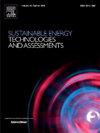Development and selection of lignocellulose biomass and nano-additive combination for co-pyrolysis operation in power generation using hybrid prediction and Machine learning model – A k-means cluster approach
IF 7.1
2区 工程技术
Q1 ENERGY & FUELS
Sustainable Energy Technologies and Assessments
Pub Date : 2024-10-30
DOI:10.1016/j.seta.2024.104061
引用次数: 0
Abstract
The burning of carbon rich fuels is associated to be the primary cause of developing large quantity of greenhouse gases which alters the earth’s ecosystem, thereby causing problems in human health and environment. This study investigates the use of various lignocellulose biomass sources—Sugarcane Bagasse, Rice Husk, Wheat Straw, Moringa, and Vetiver—in conjunction with different nanoparticles to create combinations aimed at reducing volatile matter to be used in co-pyrolysis operation in a thermal powerplant. The chosen outcome parameters for clustering these nanoparticles include energy yield, combustion efficiency, ash generation, and SO2 emission. An Adaptive Neuro Fuzzy Interface System (ANFIS) model is employed to identify trends and relationships between biomass-nanoparticle combinations and the output parameters. K-means cluster analysis is used to categorize the combinations into best, worst, and average clusters. The ANFIS algorithm reveals that the relationship is Trapezoidal with the smallest combined error rates. Among the tested combinations, Moringa coupled with silver nanoparticles emerged as the optimal biomass-nanoparticle pair, exhibiting the smallest centroidal distance of 0.14 from the best cluster centroid. Moringa and Silver nanoparticles achieved significant cost reduction and emissions reduction, with outputs showing an energy yield of 19.8 Mg/kg, combustion efficiency of 82.4 %, ash generation of 2.7 %, and SO2 emission of 0.2 g/kg.
利用混合预测和机器学习模型开发和选择用于联合热解发电的木质纤维素生物质和纳米添加剂组合 - K-均值聚类方法
燃烧富碳燃料是产生大量温室气体的主要原因,温室气体改变了地球的生态系统,从而给人类健康和环境带来问题。本研究调查了各种木质纤维素生物质来源(甘蔗渣、稻壳、小麦秸秆、辣木和香根草)与不同纳米粒子的结合使用情况,以创造出旨在减少挥发性物质的组合,用于热电厂的共热解操作。对这些纳米粒子进行聚类所选择的结果参数包括能量产量、燃烧效率、灰分产生量和二氧化硫排放量。采用自适应神经模糊接口系统(ANFIS)模型来确定生物质-纳米颗粒组合与输出参数之间的趋势和关系。K-means 聚类分析用于将组合分为最佳、最差和平均聚类。ANFIS 算法显示,两者之间的关系为梯形,综合误差率最小。在测试的组合中,辣木与纳米银颗粒是最佳的生物质-纳米颗粒组合,与最佳聚类中心点的中心距最小,仅为 0.14。辣木和银纳米粒子显著降低了成本并减少了排放,结果显示能量产量为 19.8 兆克/千克,燃烧效率为 82.4%,灰分产生率为 2.7%,二氧化硫排放量为 0.2 克/千克。
本文章由计算机程序翻译,如有差异,请以英文原文为准。
求助全文
约1分钟内获得全文
求助全文
来源期刊

Sustainable Energy Technologies and Assessments
Energy-Renewable Energy, Sustainability and the Environment
CiteScore
12.70
自引率
12.50%
发文量
1091
期刊介绍:
Encouraging a transition to a sustainable energy future is imperative for our world. Technologies that enable this shift in various sectors like transportation, heating, and power systems are of utmost importance. Sustainable Energy Technologies and Assessments welcomes papers focusing on a range of aspects and levels of technological advancements in energy generation and utilization. The aim is to reduce the negative environmental impact associated with energy production and consumption, spanning from laboratory experiments to real-world applications in the commercial sector.
 求助内容:
求助内容: 应助结果提醒方式:
应助结果提醒方式:


